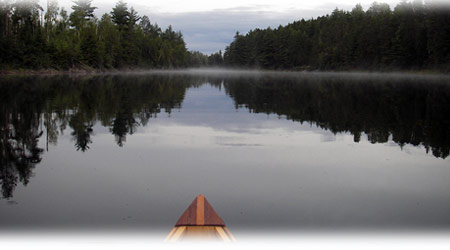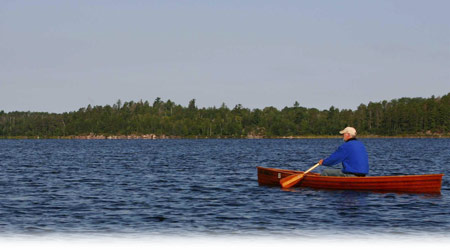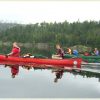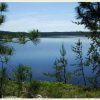Old Meets New
One paddler takes a solo canoe trip and joins the 21st century
What greeted me as I delved into the packaging was, “Welcome. Opening this box is the first step to making sure you don’t come home in one.” Maybe there were good reasons to join the 21st century after all.
I have always thought of myself as an old-fashioned kind of guy. I paddle a wooden canoe, don’t know how facebook works; I even have a working 8-track tape player (though finding new tapes is getting tough). Unfortunately, having recently turned 50, I was feeling not so much old-fashioned, but just old. In looking for a way to reaffirm my abilities and self reliance, I began to mentally search for a personal challenge. Having visited the Boundary Waters a half dozen times over the previous twenty years, I knew the challenges and rewards of a trip to the Boreal Forest. To transform a trip there into more of a personal challenge, I considered, for the first time, a solo trip. I could spend some time being totally self-reliant including outfitting myself, using my wooden solo canoe that I had built twenty years before. By going after Labor Day, I was sure there would be plenty of solitude.
While up for a challenge, I wasn’t looking to put my life on the line unnecessarily. Since the trip would be in September, not seeing other parties for days at a time was likely. My biggest worry was to be sick or injured with no one to help or get help. Despite being proudly old-fashioned, I found myself opening a box containing a Spot Satellite Personal Tracker.
The Spot weighs half a pound and can send prewritten text messages or emails, along with a Google map of the sender’s location, from nearly anywhere to preselected phone numbers and email addresses. You can send an “OK” message or an “I need help” message. In an emergency situation, a 911 message can be sent directly to the closest search and rescue unit. The cost of the unit, along with a year’s worth of service, was approximately $250. Michelle, my wife, while supportive of the trip, was plainly worried. While I knew the chances of needing the unit were remote, I did not want my last thoughts to be, “Why didn’t you spend the money you cheap dumb ass?”
Set up was simple, even for a technologically challenged person. The OK message was simply, “I’m OK. Here’s a map of where I am.” The Help message was a bit more detailed. “Things aren’t going quite as planned. While I’m not in danger, I need help to get out. Please call xxx with my location.” The 911 message is set; you just provide contact phone numbers to be sent along to the nearest Search and Rescue. I had the OK and Help messages set to be sent to Michelle and my brother Bob, who had joined me on Boundary Waters trips in the past. Bob, the typically optimistic member of the family, ask that I keep the Spot on me as I double portaged. “The last thing you want is to get a compound leg fracture and have that Spot thing a quarter mile away with the other load.” While a compound fracture was pretty low on the list of what I want regardless of the situation, it was a point well taken. Spot would remain with me at all times.
The non-technical portion of the preparation went smoothly and I arrived at Williams & Hall Outfitters near Ely, Minnesota the afternoon before Labor Day. The route was to be pretty open, a motor tow to the Birch Lake portage, travel to Knife Lake and then several options for a few days were laid out depending on weather and my speed of travel. My boat is stable, maybe a little slow, though I’d never carried much weight in it before.
After a fairly sleepless night, dawn breaks on a beautiful morning that promises a following breeze to assist with my travels. As we travel up Moose Lake towards Birch, Blaine Hall, the outfitter’s owner, veers the motorboat to show me some roosting eagles. Surrounded by the beauty of the day, my trepidation of a solo trip vanishes. After trading farewells, I begin my journey hoping to find a challenge, solitude and a few fish in a beautiful wilderness.
Paddling east on Birch Lake I immediately notice, even with a bit of a tailwind, how slow the loaded boat is. The beautiful weather more than makes up for the pace and, double portaging, I’m through Birch to Carp and then the smaller lakes of Melon and Seed by lunch. Though my stamina is being sapped by the slow, hard paddling, I continue on through Portage Lake and into Knife by early afternoon. I pull into South Bay and pick a gorgeous campsite tucked well back in a small cove out of the way. I had seen a few other parties during the day, but they all appeared to be heading in, ending their trips on the holiday. After setting up camp, I cool off with a swim, send out an OK message with the Spot and leisurely prepare a steak dinner to cap off the day.

After a good night’s sleep, I awake to broken clouds and a steady wind from the southwest. Gathering together lunch, camera, rain gear and fishing gear, I set out for Dix Lake to cast for Pike. Even with a short stop to take a few shots of an eagle perched on a high snag, I cover the 4 miles to the high overlook near the Bonnie Lake portage in well under an hour. The view west is tremendous even though the clouds are becoming solid and hanging lower. With the wind picking up I’m glad to portage into Bonnie and get off the big water of Knife. Two more relatively short portages have me on Dix Lake where I eat lunch, send an OK message with the Spot and cast for uncooperative pike. The rain, which had threatened for a while is now coming down in waves. I have two options for getting back to camp. I can take three short portages back to Knife and fight the wind on big water, or take five portages that totaled over 500 rods and return through Vera Lake. Not a fan of long, steep portages in the rain, I convince myself the wind is easing off and head back through Bonnie.
Once back on Knife, the wind, of course, picks up in intensity. I cinch the life jacket up tight, and paddling for all I’m worth, fight from island to island. At each open water crossing, I yell encouragement to myself to keep up the adrenaline level. The boat is stable through the waves, but progress is painfully slow. The closer I get to camp, the more the wind and waves conspire to slow my progress. After three hours on Knife, soaked and tired to the bone, I finally make it back to camp. Challenge is checked off the to-do list. After dinner under the tarp and a visit to the flask to settle nerves, it’s an early night.
The rain comes down on and off all night, ending for good around dawn. I decide not to move camp, but instead spend the day drying out and exploring the area. As often happens after a strong storm, the sky clears, turning the day picture perfect. I leisurely check out Portage Lake and also Vera Lake, sending an OK message from there while lying on the bank in the warm sun. Back at the campsite by mid-afternoon I’m joined in the cove by a family of loons. They’re followed by a group of five river otters that spend over an hour oblivious to my presence, frolicking, fishing and generally putting on a show. Sitting and watching their antics, I realize I haven’t seen another person since the first day. Solitude is mentally checked off the list.
Catching a few fish remain on my to-do list and so I paddle to a nearby steep, rocky shoreline to cast a jig for smallmouth. My first cast results in a chunky, foot long fighter. As the second cast hits the now calm water, an eagle that had been perched unnoticed nearby is spooked. It glides down near the canoe before flying off to a new perch overlooking camp. The beautiful sunset is spent catching and releasing eager smallies. None are bragging size, but they fill the bill perfectly.
I awake early on day four refreshed and ready to travel. Since I’m paddling back to the outfitters without the benefit of a tow, the plan is to move closer to Moose Lake, paddling until the inevitable head winds start; making for a shorter trip out the next day. Not relishing a re-enactment of the battle against the wind with a boatload of equipment, I push off shortly after dawn with the air dead-still and Knife Lake mirror smooth. Portaging through Seed and Melon Lakes, the air stays calm and the only ripples on the water are made by each lake’s resident beaver as they pass near the canoe on their morning rounds. By midmorning I’m on Carp Lake. Since Bob and I had camped there years before with his sons, I sent an OK message as I travel through.
What I didn’t know until my return was that Bob & Michelle are trading emails with each Spot message I send, discussing my progress and dispelling Michelle’s concerns. “Jim looks like he’s in the middle of the lake. Do you think he’s in his boat?” “If he’s not, I doubt he would be sending the OK. I know exactly where he is. We were there…”
It’s not until Birch Lake that there is the first hint of a breeze, and it’s a tailwind! Can I be that lucky? It appears that every site on Birch is empty, but with a tailwind, the urge to keep moving takes over. Lunch is spent on a high bank overlooking Sucker Lake and several eagle roosts. I’m only a couple hours from the take out. The sky is partly cloudy, the temperature about 60 degrees with a light wind out of the northeast; perfect conditions for travel with a slow boat. Pushing on, I cross Sucker, Newfound and Moose Lake to arrive at Williams & Hall in mid-afternoon. After a cold refreshment and a recap of the trip, it’s time to load up and start the long drive home. While the trip isn’t exactly what was anticipated, it is exactly what I need.
The Spot Messenger, while not fitting in with my “old-fashioned” self image, was a worthwhile tool to ease both my mind and Michelle’s. There is no doubt that on a solo trip, or any trip with one canoe, the Spot could be a lifesaver. Maybe I’m not as old-fashioned as I think. Next time, perhaps a Kevlar boat? Hmm, something to think about.











